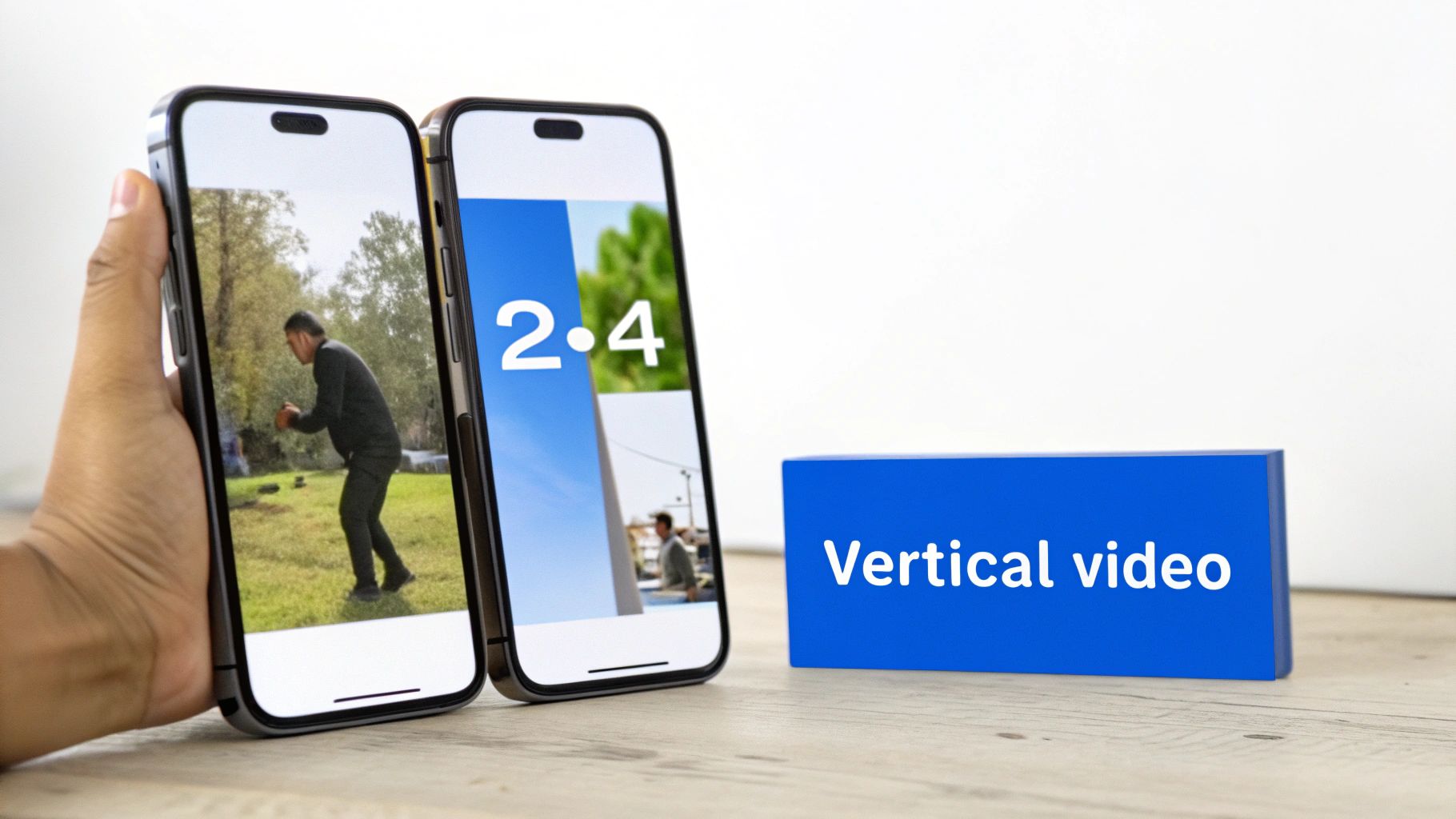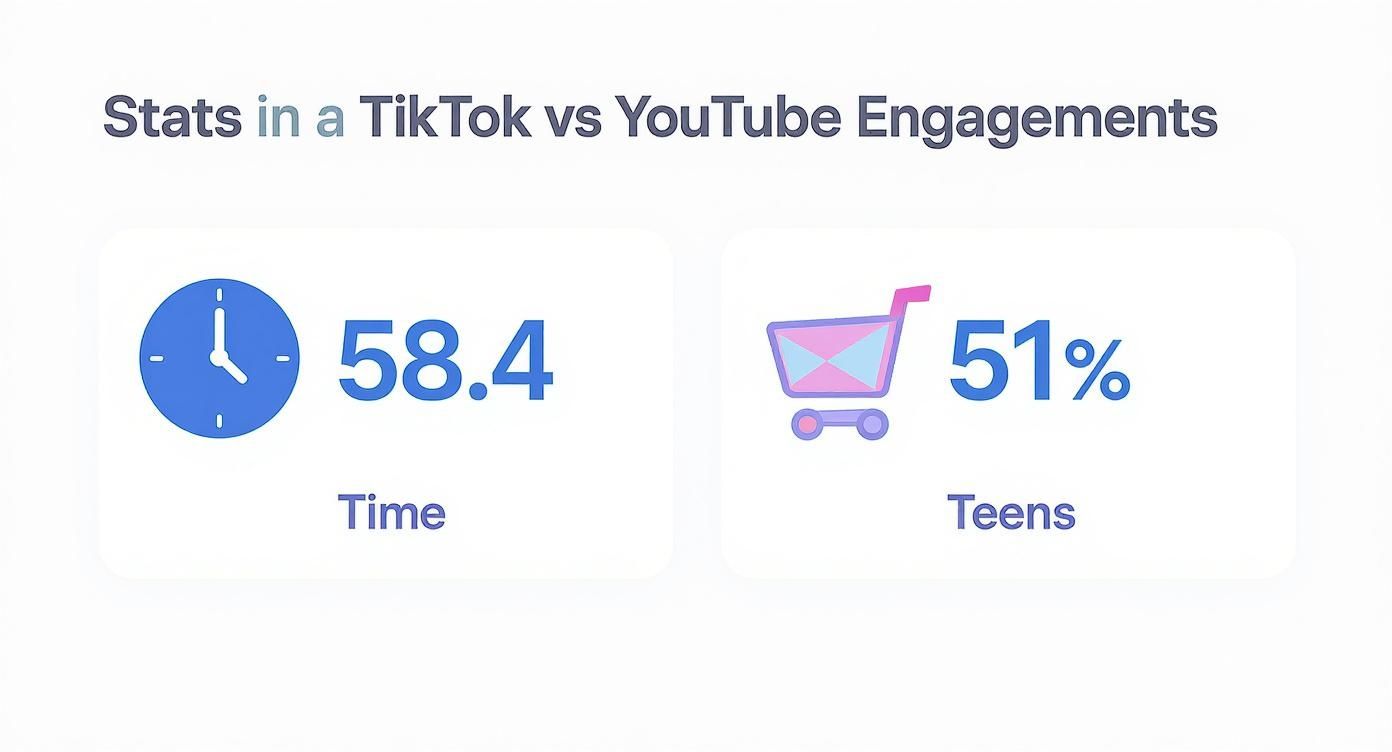Welcome to the new battlefield for your attention: TikTok vs. YouTube Shorts. At a glance, they look the same—endless scrolls of vertical video. But dig a little deeper, and you'll see they play entirely different games.
TikTok is the wild, trend-driven party where viral moments are born. YouTube Shorts, on the other hand, is the clever appetizer designed to lead viewers to the main course—your full-length YouTube content. Nailing the difference between them is the first real step to building a massive audience on both.
The Vertical Video Revolution

Short-form vertical video isn't just a trend anymore; it's a full-blown revolution. It has completely rewired how we consume media. The days of settling in for long, horizontal videos are fading. Today, it’s all about quick, punchy, mobile-first content that captures our attention in seconds and racks up billions of daily views.
This shift is a golden opportunity for creators. Platforms like TikTok and YouTube Shorts have smashed the barrier to entry, giving anyone with a smartphone a shot at reaching millions. But here’s the catch: while the video format is nearly identical, the user behavior and strategic purpose of each platform couldn’t be more different.
A Tale of Two Platforms
Let's break it down with an analogy.
Think of TikTok as a massive, chaotic city square. It's where trends explode, memes are born, and cultural moments spread like wildfire. It's the ultimate place to get discovered, capture lightning in a bottle, and achieve insane short-term reach. It’s fast, unpredictable, and powerful.
Now, think of YouTube Shorts as a series of compelling movie trailers playing outside a grand cinema—your main YouTube channel. Shorts use that same addictive, fast-paced format to grab new eyeballs, but their core job is to convince those people to buy a ticket and see the full feature film. The goal isn't just a view; it's to build a loyal, long-term community.
Why Mastering Both Is a Game-Changer
Stop thinking of the tiktok shorts youtube dynamic as a rivalry. Start seeing it as a powerful, complementary ecosystem. When you get how each platform works, you can build a content machine that's far more resilient and effective. A winning strategy uses both to their full potential:
- Maximize Discovery: Cast the widest net possible. Use both platforms to pull in different segments of your ideal audience who might not find you otherwise.
- Build Community: Use the instant buzz from TikTok and the targeted reach of Shorts to funnel genuinely interested viewers back to a central hub, like your main channel or email list.
- Strategic Repurposing: Create a piece of core content and then intelligently adapt it for each platform’s unique culture and algorithm. This lets you dominate both without doubling your workload.
Of course, none of this matters if your video looks terrible. Getting the visual presentation right is non-negotiable. For a deep dive on that, check out our complete guide on the best aspect ratios for TikTok, YouTube, and Instagram.
How YouTube Shorts Turns Views into Community

While TikTok is all about the quick thrill of explosive, short-lived trends, YouTube Shorts is playing an entirely different game. It’s not really a standalone platform but more of a strategic on-ramp, designed to pull new viewers into the much larger YouTube world.
Think of each Short as a powerful trailer for your main channel. It gives audiences a quick taste of your personality and content style, enticing them to stick around for the main event.
This deep integration is where YouTube’s real power lies. A viral Short doesn’t just give you a fleeting moment in the spotlight; it actively funnels a fresh audience to your long-form videos, subscriptions, and community features. It’s designed to turn passive scrollers into long-term fans who are genuinely invested in what you do next. This is where you can use the excitement of short-form to build something sustainable.
Understanding the YouTube Shorts Audience
The crowd on YouTube Shorts is unique, and it’s growing at an incredible pace. Since its launch, it has become a true juggernaut in short-form video, projected to hit 2 billion monthly active users globally by 2025. Daily views are already pushing toward 200 billion.
In the United States alone, the platform boasts around 164.5 million active users, making it a massive pool of potential subscribers. If you want to dive deeper into the numbers, check out these insights on short-form video platform growth on mediacomponents.com.
The biggest demographic slice is adults aged 25 to 34, who make up 21.5% of the user base. This audience isn't just looking for a quick laugh; they're often already established on YouTube and are actively searching for creators to follow for the long haul. That makes them a prime target for anyone looking to build a dedicated community.
The ultimate goal of a YouTube Short isn't just to get a view—it's to earn a click. Each Short is a call-to-action, inviting viewers to explore the deeper, more substantial content waiting on your main channel.
Key Tools for Creator Success
YouTube gives creators a suite of tools specifically designed to bridge the gap between their short-form and long-form content. Getting a handle on these features is crucial for turning fleeting views into a loyal following.
- Direct Linking: You can easily link a related long-form video right from your Short. This creates a frictionless path for anyone who wants to dive deeper into a topic you've just teased.
- The "Remix" Feature: This lets you grab audio or video clips from your own long-form content to create bite-sized promotional Shorts. The best part? It automatically links back to the original video, acting as a built-in repurposing tool that drives traffic.
- Extended Video Length: Shorts can now be up to three minutes long. This gives you way more creative breathing room to tell a compelling story or deliver enough value to get viewers hooked and wanting more.
By putting these tools to work, you can transform your Shorts from simple vertical videos into powerful discovery engines. Each one becomes a strategic piece in your channel's growth puzzle, actively working to expand your audience and strengthen your community.
Decoding the TikTok Viral Algorithm
While YouTube Shorts is busy trying to lead you back to its massive library of long-form videos, TikTok is playing an entirely different game. It’s a self-contained universe built for one thing and one thing only: maximum engagement through rapid, passive discovery. The engine making it all happen is its legendary 'For You' page, an algorithm that has absolutely mastered the art of keeping you glued to your screen.
Think of the 'For You' page as the world's best content DJ. It doesn't ask what you want to see; it learns what you love with terrifying accuracy based on every single swipe, like, and share. From there, it serves up a never-ending, personalized stream of videos it predicts you’ll enjoy, creating an addictive, lean-back experience that’s all about entertainment and instant gratification.
This laser focus on instant discovery is exactly what makes TikTok the undisputed king of trends. The algorithm is wired to give every single video a shot at viral fame, no matter how many followers the creator has. A totally unknown user can post a video that explodes overnight, turning them into a household name just because it hit the right nerve in TikTok's culture of fast-moving participation.
The Epicenter of Gen Z Culture
TikTok’s real power comes from its deep, almost symbiotic relationship with a younger audience, especially Gen Z. These users don’t just watch content; they actively create and shape it by jumping on trends, challenges, and memes. This constant collaboration has turned TikTok into a cultural juggernaut, capable of launching songs, products, and ideas straight into the mainstream.
For creators, this is a golden opportunity. Success on TikTok isn't about the slow, steady grind of building a following—it's about plugging directly into the cultural zeitgeist. The key is to make content that feels native, authentic, and participatory. The platform’s creative tools, like its massive sound library and interactive filters, are designed to fuel this exact kind of spontaneous creation. If you want to get a real handle on how to make a viral TikTok, you have to master these tools first.
Engagement and Influence by the Numbers
TikTok’s dominance is written all over its jaw-dropping engagement stats. In the United States alone, users spend an estimated 58.4 hours every month on the app. That insane level of attention gives the platform a huge influence on what people buy. But it's worth noting that YouTube Shorts is quickly catching up. One study found that 51% of U.S. teen boys made a purchase after seeing ads on Shorts—a higher rate than those who did on TikTok. You can find more insights on teen purchasing behavior on emarketer.com.
The fundamental difference is user intent. People go to YouTube with a purpose—to search for something specific. They open TikTok to be entertained and surprised, making it a platform driven by discovery, not search.
Comparing Platform Features and Monetization
So, you're trying to decide between TikTok and YouTube Shorts. On the surface, they look pretty similar—just vertical videos, right? But once you pop the hood, you’ll find they’re fundamentally different machines.
Choosing the right one isn’t just about the format; it’s about understanding their unique creative tools, how they engage audiences, and the paths they offer to actually make a living. The key is to match what each platform does best with your own goals as a creator.
A major fork in the road is video length. YouTube Shorts now lets you create videos up to three minutes long, a big jump from its initial 60-second limit. But TikTok still holds the crown with a ten-minute maximum. That extra time on TikTok opens the door for deeper storytelling, detailed tutorials, or even multi-part series all in one video. YouTube's shorter format, on the other hand, pushes you to be punchy and get straight to the point.
This infographic breaks down some of the key differences in how users behave on each platform, from screen time to spending habits.

As you can see, TikTok is the undisputed king of keeping people glued to their screens. But when it comes to influencing teen purchases, YouTube Shorts has some serious sway.
Creative Tools and Engagement Features
When it comes to actually making your videos, TikTok’s in-app editor is often seen as the more intuitive and feature-rich option. It's famous for its massive library of trending sounds and a constant stream of new, creative filters. Features like Duets and Stitches are baked into its DNA, fostering a truly interactive and participatory culture that’s hard to replicate. The whole platform feels built for speed and jumping on trends, which makes it incredibly welcoming for new creators.
YouTube's answer to this is its "Remix" feature, which works similarly. But YouTube’s real trump card is its seamless integration with the main platform. The ability to link a Short directly to one of your long-form videos is a game-changer. It creates a powerful funnel to move casual viewers into becoming dedicated subscribers, a trick TikTok just can't pull off.
Monetization Models and Creator Income
This is where the two platforms really diverge. How you earn money as a creator is completely different, and each model is built to reward different kinds of content and strategies. Let’s lay it all out.
To make things crystal clear, this table breaks down the key feature differences side-by-side.
TikTok vs YouTube Shorts Feature Comparison
| Feature | TikTok | YouTube Shorts |
|---|---|---|
| Max Video Length | 10 minutes | 3 minutes |
| Monetization Program | Creativity Program Beta | YouTube Partner Program (YPP) |
| Eligibility | 10k followers, 100k views in 30 days | 1k subscribers, 10M views in 90 days |
| Primary Income Source | Variable payouts, brand deals, TikTok Shop | Ad revenue share, channel memberships |
| Best For | Trend-driven content, virality, community engagement | Building a long-term audience, stable income |
| Unique Features | Duets, Stitches, vast sound library | Direct links to long-form videos, "Remix" |
The table really highlights the core strategic differences. TikTok is built for viral moments and rapid growth, while YouTube Shorts is designed as an on-ramp to a more sustainable, long-term content business.
-
YouTube Shorts Monetization: The primary route to getting paid is through the YouTube Partner Program (YPP). If you hit 1,000 subscribers and rack up 10 million valid Shorts views in 90 days, you're in. From there, you earn a cut of the ad revenue from ads that play between Shorts in the feed. This system is generally more predictable and can be quite lucrative for creators who are in it for the long haul.
-
TikTok Monetization: TikTok's main program is the Creativity Program Beta, which replaced the old Creator Fund. Payouts are calculated based on a mysterious mix of factors like views, engagement, and even where your viewers are located. This often leads to less consistent and predictable earnings. Beyond the program, creators can also earn through "Tips" from fans and brand deals via the Creator Marketplace.
Ultimately, YouTube offers a more direct and integrated path to stable, ad-based income, while TikTok's monetization relies more on a mix of its creator program, brand deals, and live streaming gifts.
For creators who are serious about turning their content into a reliable revenue stream, YouTube’s structured model is often the more attractive option. If that sounds like you, then it’s worth digging into the details. To help you get started, we put together a comprehensive guide on how to monetize YouTube Shorts.
Of course, monetization isn't limited to what the platforms offer directly. Thinking outside the box and exploring broader strategies for monetizing creative content can open up entirely new income streams, no matter which platform you choose.
A Smart Workflow for Repurposing Content

Trying to manage content for both TikTok and YouTube Shorts can feel like you’re running two completely separate channels. But it doesn't have to double your workload.
The secret? Stop creating unique videos for each platform from scratch. Instead, think "create once, publish everywhere." It all starts with producing one core, high-quality vertical video that you can then strategically adapt for each platform’s unique vibe.
This whole process is a smart approach to repurposing content for social media, saving you a ton of production time. By focusing on a single "master" video, you set yourself up for customized distribution without burning out.
The most important step is to edit this master video using a third-party app. This keeps it clean and free of watermarks, which both platforms' algorithms are known to penalize.
Crafting Your Master Video
Think of your master video as the director's cut. It should be the most polished, versatile version of your idea—the raw material you'll later customize for TikTok and YouTube.
Here’s what to nail down during this first creation phase:
- Prioritize High-Quality Footage: Always record in the highest resolution you can. Clean visuals and crisp audio are the foundation for a video that performs well anywhere.
- Keep Your Edits Neutral: Stick to clean cuts and simple transitions. For now, avoid adding any text, stickers, or sounds that are hyper-specific to one platform's trends.
- Structure for Flexibility: Make sure your video has a killer hook in the first three seconds, but structure the story so it can be slightly shortened or extended later without losing its punch.
This approach gives you a pristine asset ready to be molded for the distinct audiences on TikTok and YouTube. You're not locked into one style.
The goal isn't to just copy and paste. True repurposing is about thoughtful adaptation. You're translating your core message for two different cultural languages, ensuring it resonates authentically with each audience.
Platform-Specific Customization
With your master video ready, the real strategy begins. This is where you tailor the content to feel native to both TikTok and YouTube Shorts, a process that goes way beyond just hitting "upload" on the same file.
Here's a step-by-step plan for adapting your content:
- Sound and Music Selection: Upload your master video into each app's native editor. For TikTok, scroll the "For You" page to find trending audio that matches your video's mood. For YouTube Shorts, browse its library for popular tracks or use the "Remix" feature to sample audio from other videos.
- Text and Captions: Add text overlays inside each app. TikTok audiences often love bold, story-driven text that pops. On YouTube Shorts, captions can be more direct and informational, maybe pointing viewers to a related long-form video on your channel.
- Hashtag Strategy: Your hashtags need to be platform-specific. On TikTok, use a mix of broad, trending hashtags (#fyp) and niche community tags. For YouTube Shorts, focus on searchable keywords relevant to your channel's overall niche.
- Call-to-Action (CTA): Your CTA should match what people do on each platform. On TikTok, you might encourage users to try your sound or stitch your video. On YouTube, the best CTA often sends viewers to your main channel or a specific long-form video for a deeper dive.
Your Path to Short-Form Video Mastery
So, what’s the final verdict in the “TikTok vs. YouTube Shorts” debate? It was never really about picking a winner. The smartest creators know it’s about understanding you have two powerful, complementary tools in your arsenal. The trick is learning how to play to each one's strengths.
Think of it like this: TikTok is your megaphone. It’s where you go to get loud, tap into cultural moments, and reach the masses. You use it for explosive, trend-driven growth and getting your name out there—fast. It’s the platform for capturing lightning in a bottle.
YouTube Shorts, on the other hand, is your precision tool for community building. It acts as the perfect gateway, pulling genuinely interested viewers from the endless scroll of the Shorts feed right into your long-form videos. This is where you build a sustainable, monetizable audience that actually sticks around.
The most effective strategy isn't about choosing one over the other. It’s about building a cohesive presence where the viral energy of TikTok feeds the community-building power of YouTube.
Start experimenting. Take your best ideas, repurpose them, and tweak them for each audience. See what hits. Before you know it, you’ll have them working together to amplify your voice across the entire short-form video world.
Common Questions Answered
So, you're trying to figure out the best way to juggle TikTok and YouTube Shorts. It's a question I hear all the time, and it usually boils down to a few key concerns.
The biggest one? "Can I just post my TikToks on YouTube Shorts?" The short answer is yes, but with some major caveats. You absolutely cannot just download your video from TikTok and upload it to YouTube.
Watermarks and Audio Are Your Biggest Hurdles
YouTube's algorithm actively penalizes videos that have another platform's watermark slapped on them. Think about it—they don't want to promote their biggest competitor. Uploading a video with the TikTok logo is a surefire way to get your reach crushed.
Then there's the audio. That trending sound on TikTok might be a copyright landmine on YouTube. Using it without the right license can get your video taken down or demonetized. It's a headache you don't need.
So, what’s the workaround?
- Ditch the watermark: Always work from a clean, original video file. If you have to download from TikTok, use a third-party tool to strip the watermark before you even think about uploading it elsewhere.
- Check your audio: The safest bet is to use royalty-free music or sounds from YouTube's own audio library. If you used a trending sound on TikTok, you'll need to find a YouTube-approved alternative.
- Know your goal: Are you chasing a quick viral hit or building a long-term community? Your answer will tell you whether to lean into TikTok's fast-moving trends or YouTube's deeper audience connection.
Navigating the different audio libraries can trip up even experienced creators. When in doubt, always double-check the usage rights on each platform. It saves you from takedown notices later.
Which Platform Should I Focus On?
Deciding between TikTok and YouTube Shorts really comes down to what you're trying to achieve. TikTok is the ultimate laboratory for experimenting with wild, trendy ideas to see what sticks. YouTube Shorts, on the other hand, is a fantastic tool for building a lasting community that sticks around for your longer videos.
Don't overthink it at the start. Just begin posting and watch your analytics. A simple tracking link or just comparing the views and engagement in each platform's dashboard will tell you a lot about where your content resonates most.
A Practical Workflow
The best approach is to create a "master edit" of your video first—no watermarks, no platform-specific text, no licensed music.
From there, you can customize it for each platform. Tweak the first three seconds for a stronger hook, write a caption that fits the platform’s vibe, and add audio directly from their native libraries.
"Your fast track to better reach is simple: post a clean, watermark-free video and use native audio. That's 90% of the battle."
For most creators, figuring out the watermark, copyright, and platform fit solves the biggest repurposing puzzles. If you run into trickier issues, the community guidelines for TikTok and YouTube are your best friends.
Still not sure? Just try posting a few videos on both. You’ll quickly see where your style finds its home.
| Question | Quick Answer |
|---|---|
| Can I post my TikTok clips on Shorts? | Yes, but only after removing the watermark and checking the audio rights. |
| Which platform is better for trends? | TikTok is king for jumping on viral trends. Shorts is better for long-term growth. |
Ready to put your short-form video workflow on autopilot?
Give ShortsNinja a try and let AI handle the heavy lifting. You can automate your entire content creation process in just a few minutes.
Start your free trial today with code NINJA30 and see how much time you can save. Stop editing for hours and start growing your channels effortlessly.

